+ Open data
Open data
- Basic information
Basic information
| Entry | Database: PDB / ID: 7.0E+33 | ||||||
|---|---|---|---|---|---|---|---|
| Title | Serotonin 1E (5-HT1E) receptor-Gi protein complex | ||||||
 Components Components |
| ||||||
 Keywords Keywords | SIGNALING PROTEIN / Serotonin / 5-HT1e / BRL-54443 / GPCR / Complex / G protein / Gi | ||||||
| Function / homology |  Function and homology information Function and homology informationadenylate cyclase-inhibiting serotonin receptor signaling pathway / Serotonin receptors / serotonin binding / G protein-coupled serotonin receptor activity / neurotransmitter receptor activity / G protein-coupled receptor signaling pathway, coupled to cyclic nucleotide second messenger / Adenylate cyclase inhibitory pathway / positive regulation of protein localization to cell cortex / regulation of cAMP-mediated signaling / D2 dopamine receptor binding ...adenylate cyclase-inhibiting serotonin receptor signaling pathway / Serotonin receptors / serotonin binding / G protein-coupled serotonin receptor activity / neurotransmitter receptor activity / G protein-coupled receptor signaling pathway, coupled to cyclic nucleotide second messenger / Adenylate cyclase inhibitory pathway / positive regulation of protein localization to cell cortex / regulation of cAMP-mediated signaling / D2 dopamine receptor binding / G protein-coupled serotonin receptor binding / regulation of mitotic spindle organization / cellular response to forskolin / adenylate cyclase-inhibiting G protein-coupled receptor signaling pathway / Regulation of insulin secretion / G protein-coupled receptor activity / G protein-coupled receptor binding / electron transport chain / G-protein beta/gamma-subunit complex binding / Olfactory Signaling Pathway / Activation of the phototransduction cascade / adenylate cyclase-modulating G protein-coupled receptor signaling pathway / G beta:gamma signalling through PLC beta / Presynaptic function of Kainate receptors / Thromboxane signalling through TP receptor / G-protein activation / G protein-coupled acetylcholine receptor signaling pathway / Activation of G protein gated Potassium channels / Inhibition of voltage gated Ca2+ channels via Gbeta/gamma subunits / Prostacyclin signalling through prostacyclin receptor / Glucagon signaling in metabolic regulation / G beta:gamma signalling through CDC42 / ADP signalling through P2Y purinoceptor 12 / G beta:gamma signalling through BTK / Synthesis, secretion, and inactivation of Glucagon-like Peptide-1 (GLP-1) / Sensory perception of sweet, bitter, and umami (glutamate) taste / response to peptide hormone / photoreceptor disc membrane / Adrenaline,noradrenaline inhibits insulin secretion / Glucagon-type ligand receptors / Vasopressin regulates renal water homeostasis via Aquaporins / G alpha (z) signalling events / cellular response to catecholamine stimulus / Glucagon-like Peptide-1 (GLP1) regulates insulin secretion / ADORA2B mediated anti-inflammatory cytokines production / sensory perception of taste / ADP signalling through P2Y purinoceptor 1 / adenylate cyclase-activating dopamine receptor signaling pathway / G beta:gamma signalling through PI3Kgamma / cellular response to prostaglandin E stimulus / Cooperation of PDCL (PhLP1) and TRiC/CCT in G-protein beta folding / GPER1 signaling / GDP binding / G-protein beta-subunit binding / Inactivation, recovery and regulation of the phototransduction cascade / heterotrimeric G-protein complex / G alpha (12/13) signalling events / extracellular vesicle / signaling receptor complex adaptor activity / Thrombin signalling through proteinase activated receptors (PARs) / GTPase binding / retina development in camera-type eye / phospholipase C-activating G protein-coupled receptor signaling pathway / Ca2+ pathway / cell cortex / midbody / G alpha (i) signalling events / fibroblast proliferation / G alpha (s) signalling events / G alpha (q) signalling events / chemical synaptic transmission / cell population proliferation / Ras protein signal transduction / Extra-nuclear estrogen signaling / periplasmic space / electron transfer activity / iron ion binding / G protein-coupled receptor signaling pathway / cell cycle / cell division / lysosomal membrane / GTPase activity / centrosome / synapse / dendrite / heme binding / protein-containing complex binding / nucleolus / GTP binding / magnesium ion binding / signal transduction / extracellular exosome / nucleoplasm / membrane / plasma membrane / cytoplasm / cytosol Similarity search - Function | ||||||
| Biological species |  Homo sapiens (human) Homo sapiens (human)  | ||||||
| Method | ELECTRON MICROSCOPY / single particle reconstruction / cryo EM / Resolution: 2.9 Å | ||||||
 Authors Authors | Xu, P. / Huang, S. / Zhang, H. / Mao, C. / Zhou, X.E. / Shen, D.D. / Jiang, Y. / Zhang, Y. / Xu, H.E. | ||||||
| Funding support |  China, 1items China, 1items
| ||||||
 Citation Citation |  Journal: Nature / Year: 2021 Journal: Nature / Year: 2021Title: Structural insights into the lipid and ligand regulation of serotonin receptors. Authors: Peiyu Xu / Sijie Huang / Huibing Zhang / Chunyou Mao / X Edward Zhou / Xi Cheng / Icaro A Simon / Dan-Dan Shen / Hsin-Yung Yen / Carol V Robinson / Kasper Harpsøe / Bo Svensson / Jia Guo / ...Authors: Peiyu Xu / Sijie Huang / Huibing Zhang / Chunyou Mao / X Edward Zhou / Xi Cheng / Icaro A Simon / Dan-Dan Shen / Hsin-Yung Yen / Carol V Robinson / Kasper Harpsøe / Bo Svensson / Jia Guo / Hualiang Jiang / David E Gloriam / Karsten Melcher / Yi Jiang / Yan Zhang / H Eric Xu /      Abstract: Serotonin, or 5-hydroxytryptamine (5-HT), is an important neurotransmitter that activates the largest subtype family of G-protein-coupled receptors. Drugs that target 5-HT, 5-HT, 5-HT and other 5-HT ...Serotonin, or 5-hydroxytryptamine (5-HT), is an important neurotransmitter that activates the largest subtype family of G-protein-coupled receptors. Drugs that target 5-HT, 5-HT, 5-HT and other 5-HT receptors are used to treat numerous disorders. 5-HT receptors have high levels of basal activity and are subject to regulation by lipids, but the structural basis for the lipid regulation and basal activation of these receptors and the pan-agonism of 5-HT remains unclear. Here we report five structures of 5-HT receptor-G-protein complexes: 5-HT in the apo state, bound to 5-HT or bound to the antipsychotic drug aripiprazole; 5-HT bound to 5-HT; and 5-HT in complex with a 5-HT- and 5-HT-selective agonist, BRL-54443. Notably, the phospholipid phosphatidylinositol 4-phosphate is present at the G-protein-5-HT interface, and is able to increase 5-HT-mediated G-protein activity. The receptor transmembrane domain is surrounded by cholesterol molecules-particularly in the case of 5-HT, in which cholesterol molecules are directly involved in shaping the ligand-binding pocket that determines the specificity for aripiprazol. Within the ligand-binding pocket of apo-5-HT are structured water molecules that mimic 5-HT to activate the receptor. Together, our results address a long-standing question of how lipids and water molecules regulate G-protein-coupled receptors, reveal how 5-HT acts as a pan-agonist, and identify the determinants of drug recognition in 5-HT receptors. | ||||||
| History |
|
- Structure visualization
Structure visualization
| Movie |
 Movie viewer Movie viewer |
|---|---|
| Structure viewer | Molecule:  Molmil Molmil Jmol/JSmol Jmol/JSmol |
- Downloads & links
Downloads & links
- Download
Download
| PDBx/mmCIF format |  7e33.cif.gz 7e33.cif.gz | 207.1 KB | Display |  PDBx/mmCIF format PDBx/mmCIF format |
|---|---|---|---|---|
| PDB format |  pdb7e33.ent.gz pdb7e33.ent.gz | 162.8 KB | Display |  PDB format PDB format |
| PDBx/mmJSON format |  7e33.json.gz 7e33.json.gz | Tree view |  PDBx/mmJSON format PDBx/mmJSON format | |
| Others |  Other downloads Other downloads |
-Validation report
| Summary document |  7e33_validation.pdf.gz 7e33_validation.pdf.gz | 835.6 KB | Display |  wwPDB validaton report wwPDB validaton report |
|---|---|---|---|---|
| Full document |  7e33_full_validation.pdf.gz 7e33_full_validation.pdf.gz | 843.9 KB | Display | |
| Data in XML |  7e33_validation.xml.gz 7e33_validation.xml.gz | 33.8 KB | Display | |
| Data in CIF |  7e33_validation.cif.gz 7e33_validation.cif.gz | 51.3 KB | Display | |
| Arichive directory |  https://data.pdbj.org/pub/pdb/validation_reports/e3/7e33 https://data.pdbj.org/pub/pdb/validation_reports/e3/7e33 ftp://data.pdbj.org/pub/pdb/validation_reports/e3/7e33 ftp://data.pdbj.org/pub/pdb/validation_reports/e3/7e33 | HTTPS FTP |
-Related structure data
| Related structure data |  30975MC  7e2xC  7e2yC  7e2zC  7e32C M: map data used to model this data C: citing same article ( |
|---|---|
| Similar structure data |
- Links
Links
- Assembly
Assembly
| Deposited unit | 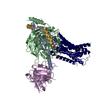
|
|---|---|
| 1 |
|
- Components
Components
-Guanine nucleotide-binding protein ... , 3 types, 3 molecules ABG
| #1: Protein | Mass: 40414.047 Da / Num. of mol.: 1 / Mutation: S47N, G203A, E245A, A326S Source method: isolated from a genetically manipulated source Source: (gene. exp.)  Homo sapiens (human) / Gene: GNAI1 / Production host: Homo sapiens (human) / Gene: GNAI1 / Production host:  |
|---|---|
| #2: Protein | Mass: 37915.496 Da / Num. of mol.: 1 Source method: isolated from a genetically manipulated source Source: (gene. exp.)  Homo sapiens (human) / Gene: GNB1 / Production host: Homo sapiens (human) / Gene: GNB1 / Production host:  |
| #4: Protein | Mass: 7861.143 Da / Num. of mol.: 1 Source method: isolated from a genetically manipulated source Source: (gene. exp.)  Homo sapiens (human) / Gene: GNG2 / Production host: Homo sapiens (human) / Gene: GNG2 / Production host:  |
-Antibody / Protein / Non-polymers , 3 types, 3 molecules ER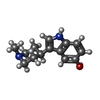

| #3: Antibody | Mass: 26466.486 Da / Num. of mol.: 1 Source method: isolated from a genetically manipulated source Source: (gene. exp.)   |
|---|---|
| #5: Protein | Mass: 57528.371 Da / Num. of mol.: 1 / Mutation: M7W,H102I,R106L,L111W Source method: isolated from a genetically manipulated source Details: The BRIL (soluble cytochrome b562) protein was used as the expression tag Source: (gene. exp.)   Homo sapiens (human) Homo sapiens (human)Gene: cybC, HTR1E / Production host:  |
| #6: Chemical | ChemComp-HVU / |
-Details
| Has ligand of interest | Y |
|---|
-Experimental details
-Experiment
| Experiment | Method: ELECTRON MICROSCOPY |
|---|---|
| EM experiment | Aggregation state: PARTICLE / 3D reconstruction method: single particle reconstruction |
- Sample preparation
Sample preparation
| Component |
| ||||||||||||||||||||||||
|---|---|---|---|---|---|---|---|---|---|---|---|---|---|---|---|---|---|---|---|---|---|---|---|---|---|
| Source (natural) |
| ||||||||||||||||||||||||
| Source (recombinant) |
| ||||||||||||||||||||||||
| Buffer solution | pH: 7.4 | ||||||||||||||||||||||||
| Specimen | Embedding applied: NO / Shadowing applied: NO / Staining applied: NO / Vitrification applied: YES | ||||||||||||||||||||||||
| Vitrification | Cryogen name: ETHANE / Humidity: 100 % / Chamber temperature: 277 K |
- Electron microscopy imaging
Electron microscopy imaging
| Experimental equipment |  Model: Titan Krios / Image courtesy: FEI Company |
|---|---|
| Microscopy | Model: FEI TITAN KRIOS |
| Electron gun | Electron source:  FIELD EMISSION GUN / Accelerating voltage: 300 kV / Illumination mode: FLOOD BEAM FIELD EMISSION GUN / Accelerating voltage: 300 kV / Illumination mode: FLOOD BEAM |
| Electron lens | Mode: BRIGHT FIELD / Nominal magnification: 29000 X / Calibrated magnification: 49310 X / Cs: 2.7 mm |
| Specimen holder | Cryogen: NITROGEN / Specimen holder model: FEI TITAN KRIOS AUTOGRID HOLDER |
| Image recording | Electron dose: 62 e/Å2 / Detector mode: COUNTING / Film or detector model: GATAN K2 SUMMIT (4k x 4k) |
- Processing
Processing
| CTF correction | Type: NONE |
|---|---|
| Particle selection | Num. of particles selected: 1486169 |
| 3D reconstruction | Resolution: 2.9 Å / Resolution method: FSC 0.143 CUT-OFF / Num. of particles: 163354 / Symmetry type: POINT |
 Movie
Movie Controller
Controller







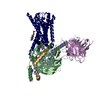
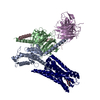
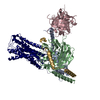
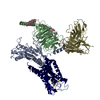
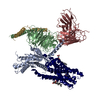
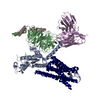

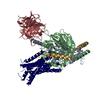
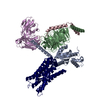

 PDBj
PDBj

































